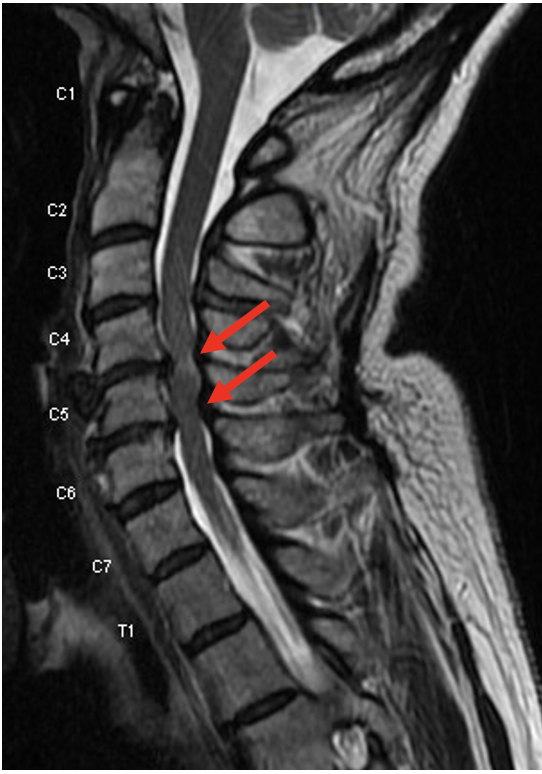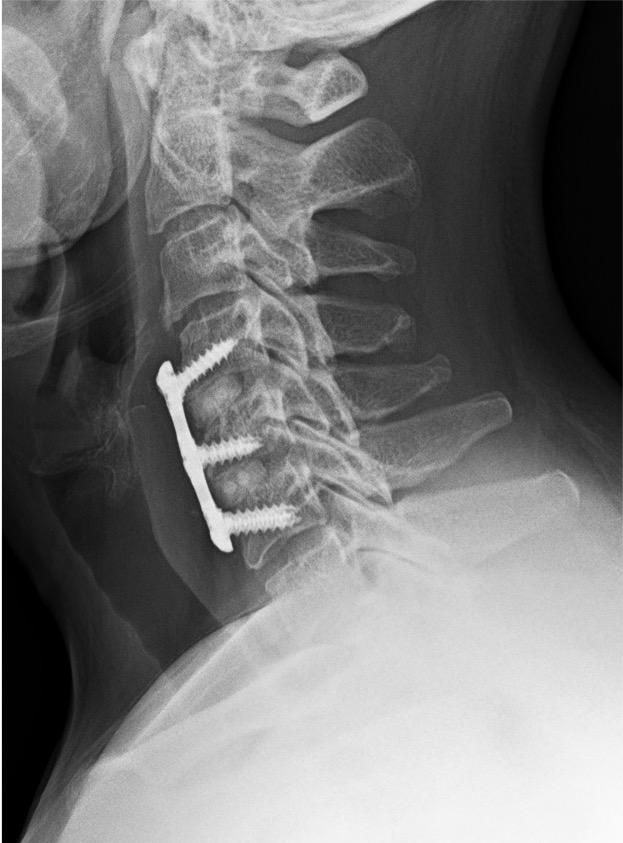
Pre-op: severe spinal cord compression at C4-6 (red arrows)

Following C4-6 ACDF
What is Anterior Cervical Discectomy and Fusion (ACDF)?
ACDF is a surgical procedure that can treat a herniated disc, stenosis (narrowing), neck pain, and instability in the cervical or neck region, and is performed by approaching the spine anteriorly, or from the front of the neck. An advantage of having it performed from the front is that it provides easier access to the cervical spine, and it may result in less pain and a faster recovery.
The primary goals of the surgery often include removal of the damaged spinal disc, trimming of bony overgrowths that can cause painful nerve compression, and achievement of stability by fusing (healing together) the adjacent vertebrae with bone graft in the space created.
What is Cervical Disc Herniation
The cervical region of the spine (the neck), is made up of 7 vertebrae that are separated by discs that act as shock absorbers. Each disc has two parts, a tough exterior called the annulus fibrosus, and a gel-like center called the nucleus pulposus.
Trauma, or just general wear and tear over time, can damage the disc and cause that gel-like center to herniate or protrude through the tough outer layer. This can put painful pressure on the spinal cord, ligaments, or nerve roots. But that’s not the only way nerve compression can occur. Sometimes it can be caused by bony overgrowths or spurs in the cervical spine. As a result, the patient can experience neck pain, as well as pain, numbness, weakness, and lack of coordination in the arms and fingers.
If these symptoms cannot be resolved through non-surgical means and they are affecting your ability to perform daily activities, then talk to your surgeon or contact us to setup an appointment to see if ACDF surgery is right for you.
How is ACDF surgery performed?
The patient will lie on their back and be put under general anesthesia. Once the patient is asleep, an incision (often horizontal and extending to one side) will be made on the front of the neck. Muscles and other important structures in the neck are carefully retracted to gain access to the surgical area, and the following steps are performed:
- The affected cervical disc is identified by X-ray imaging.
- The disc material is surgically removed to decompress and relieve the areas of nerve root and spinal cord compression.
- Any bone spurs causing the same issue are also removed.
- The space left from removing the disc is measured to receive the correct size bone graft.
- The bone graft is prepared and placed in that space. Alternatively, a fusion cage made of artificial material such as titanium or PEEK (polyetheretherketone, an organic thermoplastic polymer) is packed with bone graft and inserted in the space.
- A metal plate may be screwed into the vertebrae to provide stability
- Finally, the muscles and other important structures are carefully released from retraction and the incision is closed.
With the help of the bone graft, over time the adjacent vertebrae will grow and fuse together to form a solid piece of bone.
What happens after surgery?
You’ll be placed in a neck brace for stability and comfort, which you will be asked to wear for a specified period of time. You will also be prescribed the appropriate medication for any post-op pain. Smoking and using non-steroidal anti-inflammatory drugs or NSAIDS should be avoided as they can interfere with the bone healing and fusion process. You will be instructed to avoid lifting heavy objects or excessively bending forward or backward. Post-operative exercises can also be provided to safely restore movement as early as possible. Depending on your level of activity and your course of recovery, you may return to work and carry on with your normal life within a few weeks.
What are the risks and complications of this procedure?
As with all surgical procedures, ACDF may be associated with certain risks and complications. Some of these include:
- Infection
- Blood loss
- Blood clots
- Nerve/spinal cord damage
- Difficulty swallowing
- Hoarse voice
- Bowel and bladder problems
- Failure of the adjacent vertebrae to fuse, which may require an additional surgery
- Accelerated degeneration of adjacent spine levels
If you have any questions, comments, or concerns about ACDF and if whether it’s the right procedure to relieve your condition, talk to your surgeon or contact us to book an appointment.

